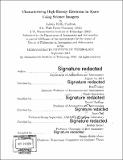Characterizing high-energy electrons in space using science imagers
Author(s)
Carlton, Ashley Kelly
DownloadFull printable version (24.70Mb)
Other Contributors
Massachusetts Institute of Technology. Department of Aeronautics and Astronautics.
Advisor
Kerri Cahoy.
Terms of use
Metadata
Show full item recordAbstract
Harsh radiation in the form of ionized, highly energetic particles is part of the space environment and can affect the operation, performance, and lifetime of spacecraft and their instruments. Jupiter has the largest and strongest magnetosphere of all of the planets in the solar system and it is dominated by high-energy electrons. Measuring and characterizing megaelectron volt (MeV) particles is fundamental for understanding the energetic processes powering the magnetosphere, interactions of the particles with surfaces of the Jovian satellites, and the effects of these particles on spacecraft near or in Jovian orbit. Electrons in Jupiter's magnetosphere can interact with spacecraft and lead to component failures, degradation of sensors and solar panels, and physical damage to materials. Dedicated instruments to monitor the radiation environment are not always included on spacecraft due to resource constraints. Measurements of the high-energy (>1 MeV) electron environment at Jupiter are currently spatially and temporally limited, predominantly coming from the Energetic Particle Detector (EPD) on the Galileo spacecraft. In this thesis, we develop ways to use existing hardware on spacecraft to measure the energetic particle environment. Solid-state detectors are commonly used as scientific imagers on spacecraft. In addition to being sensitive to incoming photons, semiconductor devices also are affected by incoming charged particles collected during integration and detector readout. These radiation hits from the space environment are typically considered "noise" at the detector. We develop a technique to extract quantitative high-energy electron environment information (energy and flux) from science imager radiation "noise". We use data from the Galileo spacecraft Solid-State Imaging (SSI) instrument, which is a silicon charge-coupled device (CCD). We post-process raw SSI images to obtain frames with only the radiation contribution. The camera settings are used to compute the energy deposited in each pixel, which corresponds to the intensity of the observed radiation hits. The energy deposited in the SSI pixels by incident particles from processed SSI images are compared with the results from 3D Monte Carlo transport simulations of the SSI using Geant4. Simulating the response of the SSI instrument to mono-energetic electron environments, we find that the SSI is capable of detecting >10 MeV electrons (>90% of <10 MeV particles are stopped with 95% confidence). Using geometric scaling factors computed for the SSI, we calculate the environment particle flux given a number of pixels with radiation hits. We compare the SSI results to measurements from the Galileo EPD, examining the electron fluxes from the >11 MeV integral flux channel. We find agreement with the EPD data within 3-sigma of the EPD data for 43 out of 43 (100%) of the SSI images evaluated. 62% of fluxes are also within 1-sigma of the EPD data. To demonstrate that the general technique is applicable to other imagers, we also analyze the Galileo Near-Infrared Mapping Spectrometer (NIMS). We find that NIMS is sensitive to >5 MeV electrons and the calculated fluxes are consistent with the EPD. This approach can be applied to other sets of imaging data (star trackers, etc.) in energetic electron environments, such as those found in geostationary Earth orbit. This thesis also includes a summary of required and recommended information (tests, models, etc.) for the use of science imagers as high-energy electron sensors.
Description
Thesis: Ph. D., Massachusetts Institute of Technology, Department of Aeronautics and Astronautics, 2018. Cataloged from PDF version of thesis. Includes bibliographical references (pages 129-140).
Date issued
2018Department
Massachusetts Institute of Technology. Department of Aeronautics and AstronauticsPublisher
Massachusetts Institute of Technology
Keywords
Aeronautics and Astronautics.